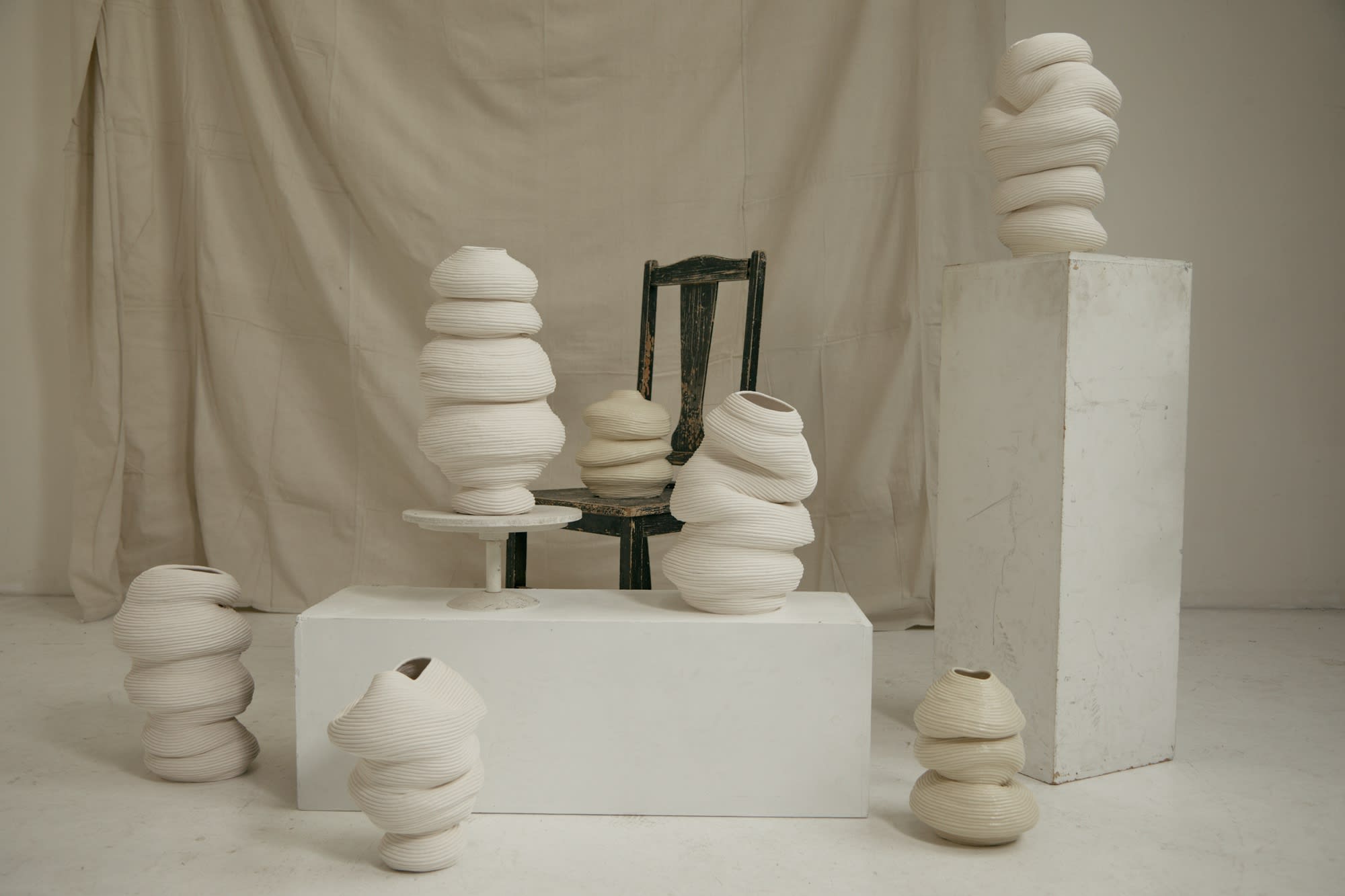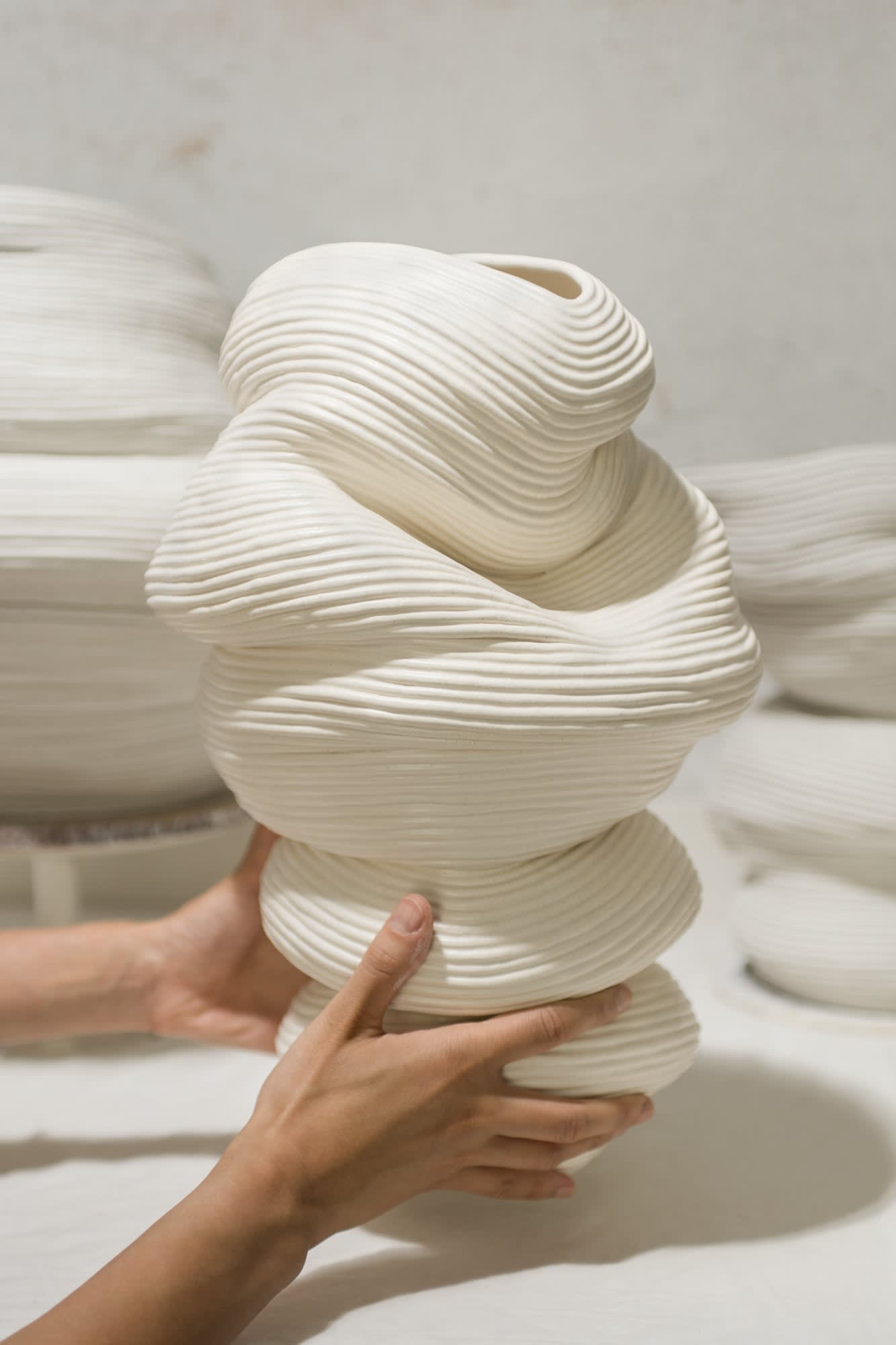
Born in Taiwan and now based in Melbourne, Australia, Zhu Ohmu is a contemporary artist who has established a practice across many creative fields. Since graduating from Elam School of Fine Arts in Auckland, New Zealand, Zhu has brought her art to life through her intuitive processes.
TLP: Describe your art practice and how it has evolved.
ZO: After art school, I moved to Melbourne and suffered a creative block for two years. Unmotivated with making 2D works, I began experimenting with more tactile mediums during this liminal period. At the same time, I noticed that something else was missing in my new life in Australia – the lack of greenery in my home. I started collecting houseplants and made amoebic planters from pinching air-dry clay. I felt revived by the ideas and feelings stimulated by this newly developed kinesthetic awareness of form, and my ceramics practice was born.
After transitioning from air dry clay to proper ceramics, I started experimenting with a coiling technique that imitates the machine methods of 3D printing. Built through stacking, folding and pressing, the vessels I make are dictated by the weight of moist clay with the form emerging intuitively, pushed to its structural limits. By spending time with the clay through play and observation, the insight into plasticity and workability allows me to manipulate the material. The artist’s hands can build forms that the present-day 3D printer cannot, and this is because humans are capable of the patience, care and curiosity needed for an intimate relationship with clay.
“By spending time with the clay through play and observation, the insight into plasticity and workability allows me to manipulate the material.”

TLP: Tell us a bit more about where you are today.
ZO: When I moved to Melbourne in 2012, the application process to exhibit in an Artist Run Initiative (ARI) was competitive, and it was the norm to pay approximately $900 to exhibit for three weeks. I was in my early 20s and fresh out of art school in a new country – I did not have the spare funds. I also don’t agree with how little support was given to emerging artists at the time, but I believe the structure has since changed and now ARIs pay artists a small fee to exhibit. Being resourceful, I started posting works on social media and garnered an online audience. I now regularly receive invitations to exhibit locally and internationally as a result of media coverage from doing interviews with blogs, magazines and news outlets. I am now represented by Gallery Sally Dan-Cuthbert in Sydney and currently have work on display as part of ‘Melbourne Now’ at the National Gallery of Victoria.
TLP: What primarily drives the final outcome of your work – function, form or material?
ZO: I was taught formalism in my first year of art school. Even though my process is intuitive, and I don’t know what the outcome will look like until the piece is built, the aesthetic value of compositional excellence is very integral to my practice.
TLP: How do you approach materials and composition?
ZO: I like to negotiate with the material by pushing it as far as possible, and then I see how it responds and then compromise. It’s a bit of a dance, a balancing act. Approaching composition is similar but perhaps more intuitive.
I am curious about how we can remain relevant in the current age of automation, where there are apprehensions of machines instigating human obsolescence.

TLP: Tell us about your process. Do you do a lot of research or is your method more instinctive?
ZO: Both. Ideas marinate in my mind for a long time, but the way I build is intuitive, so I guess my practice is very much a feedback loop where my experiments inform my research and thus inform my techniques or methodologies and vice versa. For example, 3D-printed pieces are made by stacking clay coils according to programmed measurements until the piece is completed. Computer software and a robotic arm control the nozzle that extrudes the clay, a technological innovation allowing complex ceramic designs to be printed quickly, accurately and in large numbers. Interested in subversive strategies as a way to explore, I thought about making work by emulating the mechanised process of machines by hand. This is an inversion of biomimicry, a concept where new technological innovations are discovered through the imitation of designs found in nature, but I started with the simple exercise of copying the way the 3D printer repeatedly performs the action of laying extruded coils one atop the other by hand.
Without any preliminary planning, ceramic forms emerged intuitively. Thus, my work began to investigate the resurgence of the handmade and the ethics of slowness in an age of mass production and automation while exploring the conversation between nature, the artist’s hand and new technologies. I am curious about how we can remain relevant in the current age of automation, where there are apprehensions of machines instigating human obsolescence.
TLP: Where do you find inspiration?
ZO: For me, inspiration comes from curiosity and observation. It can come from anything and everything, really, shaped by the people and things in my immediate vicinity. But it can also come from the other side of the world through my phone or laptop screen, which is quite a contemporary experience.
“I like to negotiate with the material by pushing it as far as possible, and then I see how it responds and then compromise. It’s a bit of a dance, a balancing act.”
TLP: What design philosophy underpins your work?
ZO: My lack of training in ceramics emphasises the experimentation in the self-formulated coiling process. Breakages were very common in my works in my first year of making – the technique and precarious structures often lead to cracks or the entire vessel caving in, and this can occur anytime during the making, drying or firing stage. Disheartened that I could hardly produce one piece without faults, and also not wanting to discard these ‘failures’ I’d spent many hours on, the only option was to come to terms with the nature of the material and process.
The Japanese philosophy of wabi-sabi resonated with this feeling of radical acceptance through and through. Wabi-sabi embraces the transience and imperfections of things; its aesthetic value takes pleasure in the perverse beauty of the irregular, the torn, the fractured and the decayed – wholly accepting these qualities as part of the object’s history and story. It is a worldview in which the considerations of beauty oppose the Western ideals of grandness and flawlessness, contrasting against the current throwaway culture where disposables are favoured over durable goods that can be repaired. I think wabi-sabi can teach us to tread lightly on this earth and challenge us to step out of the consumerist mindset.
TLP: What’s next for you?
ZO: An upcoming solo exhibition at the Melbourne Art Fair with Gallery Sally Dan-Cuthbert in February 2024.


